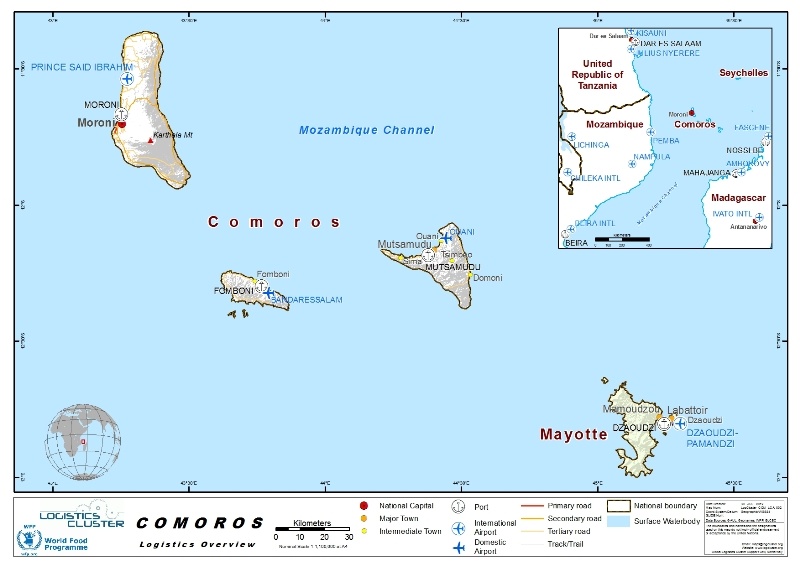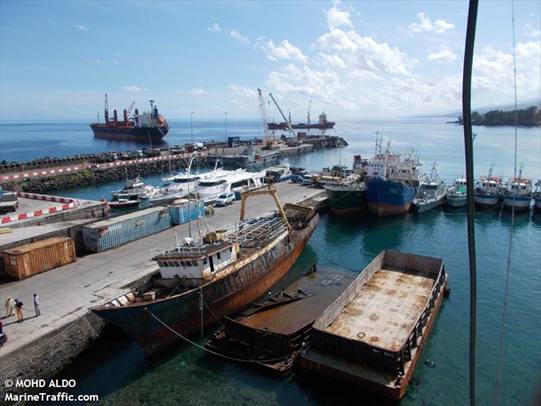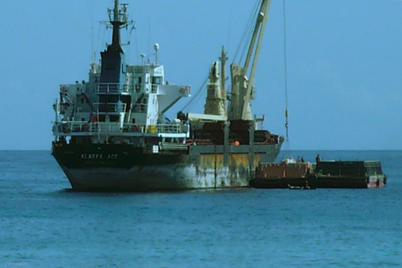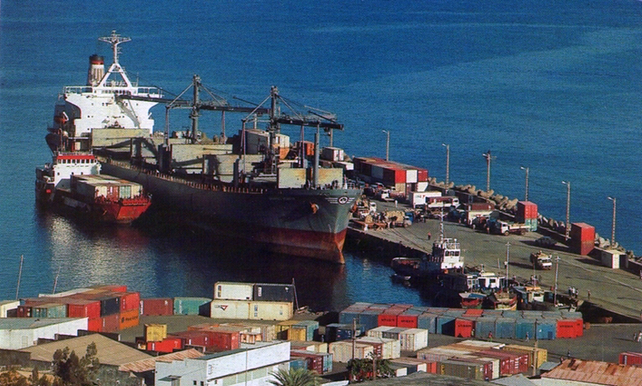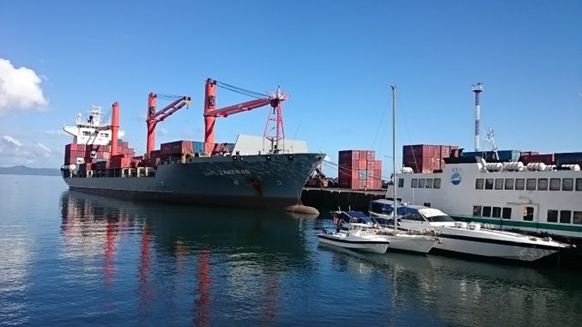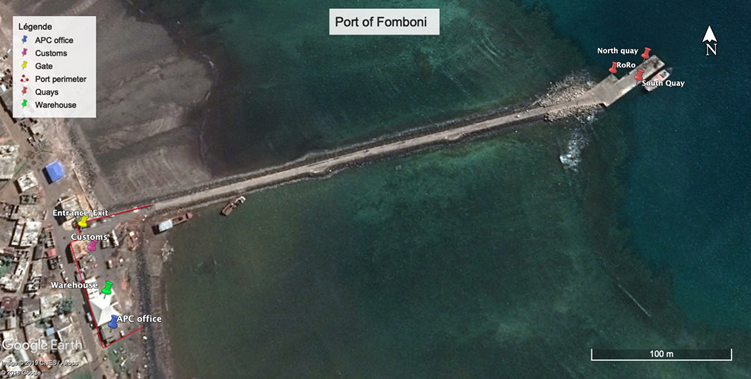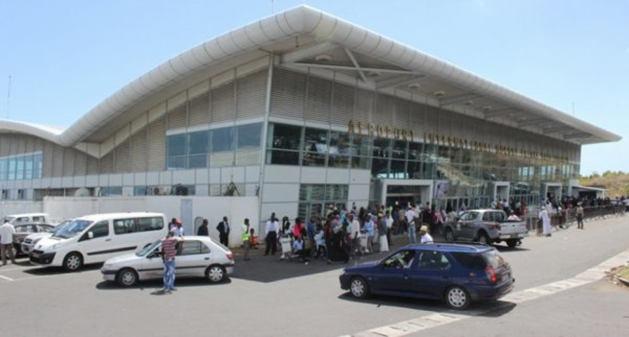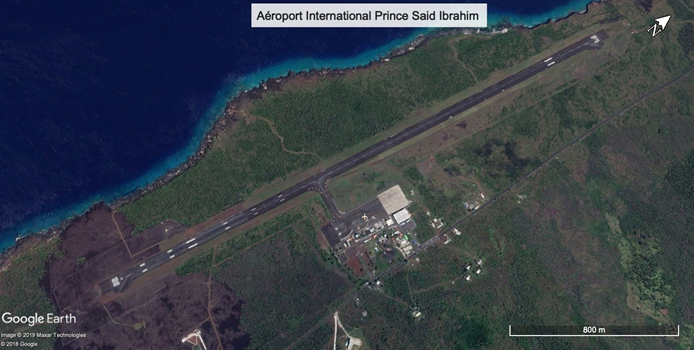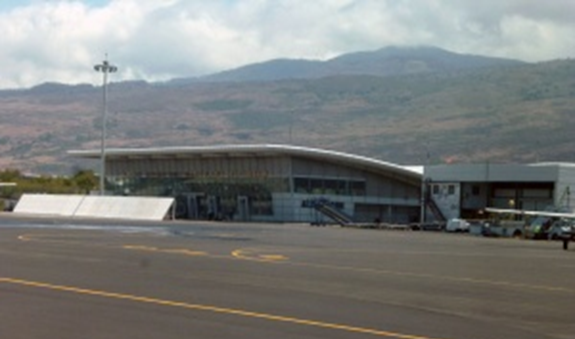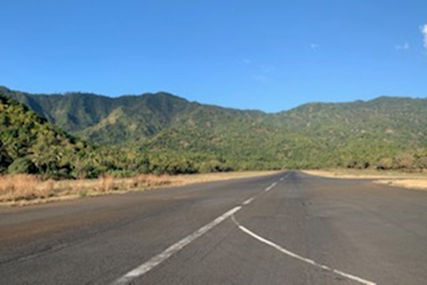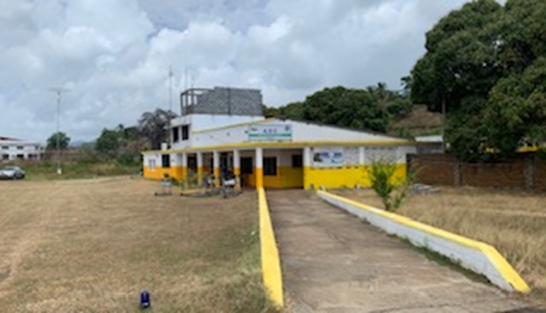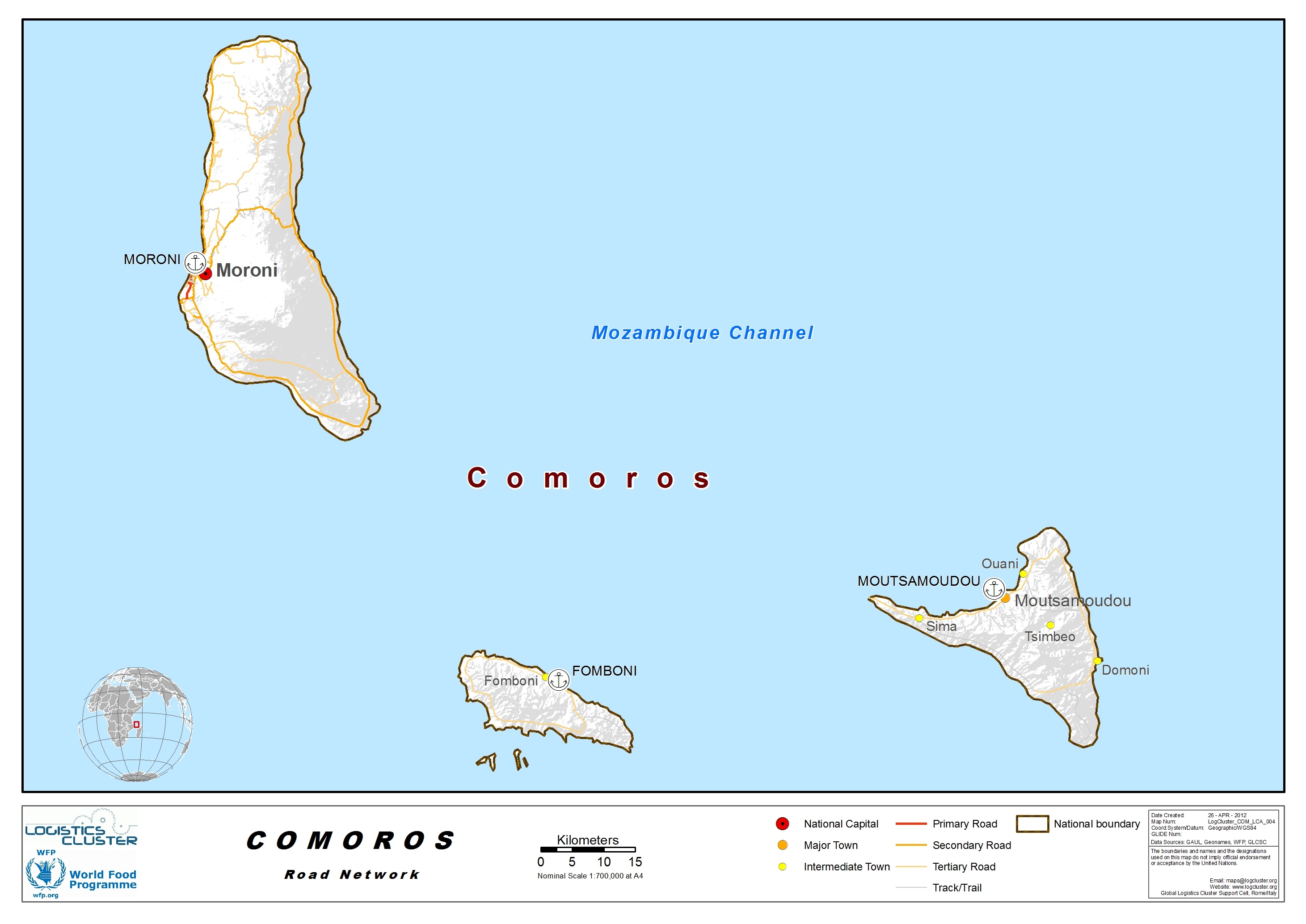2 Comoros Logistics Infrastructure
The logistics infrastructures and services of the Comoros are not well developed and aging. They are suffering of the lack of public or private investment and are not meeting international minimum standards.
Each of the three islands has a small international airport allowing for return trips to Mecca or neighbouring countries, but the only one offering long-haul flights is Moroni which is connected to Europe and Africa by regular flights.
Similarly for ports, each of the three islands has a port but only those of Moroni and Mutsamudu are containerized and called by international liners, while the island of Mohélie is supplied by the two others, which accentuates the precariousness of its inhabitants.
Basic logistical services (transport, equipment rental or warehousing companies) are very little developed, if not non-existent; each company or organization has its own fleet of equipment and storage facilities.
The General Directorate of Civil Security (DGSC) is a long-standing partner of the United Nations agencies and has been given a number of equipment and warehouses that can be made available to the international community in the event of a natural disaster.
2.1 Comoros Port Assessment
Comoros Port Assessment
Overview
The National Agency for Maritime Affairs (ANAM) is the state body responsible for regulating maritime issues directly under the jurisdiction of the Ministry of Transport, Posts and Telecommunications. It has the mission of public service and the authority to develop and operate the international maritime registry of the Union of Comoros. ANAM also aims to improve, promote and make the Comoros national maritime and port policy more competitive internationally, in compliance with the merchant shipping law of the Union of Comoros and the International Maritime Organization (IMO).
The Port Authority of the Comoros (APC) is the authority responsible for designing the legal framework (establishment of concessions) and regulating port activities (wharf access, security, etc.) in the country. In Moroni, the Bolloré Logistics Group won a tender for the concession of the handling of the port in 2012 and the Mutsamudu port concession in Anjouan is owned by Spanfreight, a subsidiary of UAFL.
Goods transport
The government estimates that 90% of the cargo to and within the Comoros is transported by sea. The Union of Comoros has two containerized ports located in Moroni (Grande Comore Island) and Mutsamudu (Anjouan Island) and a smaller one in Fomboni (Moheli Island) which can only receive bulk general cargo. At present, the port of Fomboni has no commercial relevance.
The main port of Comoros is located on the island of Anjouan, near Mutsamudu. It is a well-protected, deep-water port that can accommodate large ships.
The port of Moroni is less competitive due to the shallow waters of the port that prevent larger ships from docking. Vessels over 80 meters long remain at anchor and tranship the cargo on barges towed to the wharf and unloaded using a harbour crane.
The port of Moheli has a small wharf that can accommodate boats up to 45 meters, but barge transhipment is not available for longer vessels.
2.1.1 Comoros Port of Moroni
Port Overview
The port of Moroni is under the supervision of the APC (Port Authority of Comoros). Despite the fact that it serves the capital and the most populous island of the Comoros archipelago, the ports of Moroni is the second in terms of attendance and volume. This is due to the shallow draft (5m) at the dock which limits berthing to boats under 70m. Larger vessels must not exceed 150m and must remain in one of the two mooring areas which are 20m deep. Ships that cannot dock at the port unload their goods with their on-board cranes on barges that are then towed to the port. Moroni Terminal is in poor condition and suffers from a lack of investment.
All types of goods pass through the port: vehicles, food, general goods, and construction equipment. Exports are virtually non-existent apart from some cash crops such as cloves and ylang-ylang.
Key port information can also be found at: Maritime Database Information on Port of Moroni
|
Port Location and Contact |
|
|---|---|
|
Country |
Comores |
|
Province or District |
Grande Comore |
|
Nearest Town or City with Distance from Port |
Moroni N/A |
|
Port's Complete Name |
Port de Moroni |
|
Latitude |
11°42'12.12"S |
|
Longitude |
43°14'53.00"E |
|
Managing Company or Port Authority |
APC (Autorité Portuaire des Comores) |
|
Management Contact Person |
Mr Bacha CHEFOU Commandant du port +269 3395929 |
|
Nearest Airport and Airlines with Frequent International Arrivals/Departures |
Moroni Prince Saïd Ibrahim International Airport Regular flight to Mayotte, Madagascar, South Africa, Kenya, Réunion, Seychelles, and Turkey. |
Port Picture
Description and Contacts of Key Companies
Moroni Terminal
Handling of containerized goods or big bags
David SPEE
Director of Operations
+269 369 93 66
Collectif de Représentants Maritimes (COREMA)
Handling of goods in bulk and bag
Ahmed MOUSTALI
Manager
+269 332243
Customs
Mr Adam MOEVA
Head of Brigade
+269 3342317
For more information on port contacts, please see the following link: 4.4 Port and Waterways Companies Contact List.
Port Performance
The port of Moroni is divided into two zones, an international scheduled to handle containers and seized big-bags that another regional through which bulk goods transit and which also serves as a boat dock for passengers traveling from / to nearby islands.
The port is undersized for day-to-day operations, international ships are waiting on average 48 hours before they can unload their goods. Due to the low draft, boats over 70 meters cannot dock and must unload their goods on barges with on-board cranes.
In fact, when the weather becomes rainy or there is swell, the operations are stopped while the weather becomes lighter.
The regional wharf is also congested, unloading operations are done by hand and take several days to unload ships from Madagascar or Tanzania. These boats do not usually stay at anchor and moor with each other while waiting for their unloading tower.
In case of emergency, berthing and unloading of ships carrying humanitarian aid will be prioritized.
|
Seasonal Constraints |
||
|---|---|---|
|
Occurs |
Time Frame |
|
|
Rainy Season |
Yes |
December to April |
|
Major Import Campaigns |
No |
N/A |
|
Other Comments |
N/A |
|
|
Handling Figures for 2018 |
|
|---|---|
|
Vessel Calls (International only) |
80 |
|
Container Traffic (TEUs) imports |
1500 |
|
Container Traffic (TEUs) imports |
12 |
|
Expedition of empty containers |
1200 |
|
Handling Figures Bulk and Break Bulk for 2018 |
|
|---|---|
|
Bulk & Break bulk (MT) |
No figures |
Discharge Rates and Terminal Handling Charges
Port of Moroni handling rates.
Berthing Specifications
|
Type of Berth |
Quantity |
Length (m) |
Maximum Draft (m) |
Comments |
|---|---|---|---|---|
|
Conventional Berth |
1 |
1x 50m |
2,5m |
Regional wharf (goods / passengers) |
|
Container Berth |
1 |
1x 80m |
5m |
International wharf |
|
Silo Berth |
N/A |
N/A |
N/A |
N/A |
|
Berthing Tugs |
N/A |
N/A |
N/A |
Can be moored on the 2 wharfs |
|
Water Barges |
N/A |
N/A |
N/A |
Can be moored on the 2 wharfs |
General Cargo Handling Berths
|
Cargo Type |
Berth Identification |
|---|---|
|
Imports - Bagged Cargo |
Regional wharf |
|
Exports - Bagged Cargo |
Regional wharf |
|
Imports and Exports - RoRo |
Regional wharf |
|
Other Imports |
Petroleum products (pipeline) |
Port Handling Equipment
Handling equipment are managed and owned by the private company Moroni Terminal.
|
Equipment |
Available |
Total Quantity and Capacity Available |
Comments on Current Condition and Actual Usage |
|---|---|---|---|
|
Dockside Crane |
No |
N/A |
N/A |
|
Container Gantries |
Yes |
3 x 20` 3 x 40` |
Good condition |
|
Mobile Cranes |
Yes |
2 x 60t |
Good condition |
|
Reachstacker |
Yes |
2 x 40t |
Good condition |
|
RoRo Tugmaster (with Trailer) |
No |
N/A |
N/A |
|
Grain Elevator with Bagging Machines |
No |
N/A |
N/A |
|
Transtainer |
No |
N/A |
N/A |
|
Forklifts |
Yes |
2 x 3 MT 3 x 5 MT 1 x 12 MT |
Good condition |
|
Autres équipements |
1 Pusher / tug 400 HP 3 barges: 1 x150 MT (12 TEU) 2 x 300 MT (24TEU) 5 truck tractors 5 flatbed trailers |
||
Container Facilities
|
Facilities |
20 ft |
|---|---|
|
Container Facilities Available |
Hazardous material storage area General merchandise container storage area Reefer Zone Clearing area Empty container area |
|
Container Freight Station (CFS) |
N/A |
|
Refrigerated Container Stations |
Yes |
|
Other Capacity Details |
N/A |
|
Daily Take Off Capacity |
Between 60 and 200 containers per day depending on the weather |
|
Number of Reefer Stations |
Up to 50 connection points |
|
Emergency Take-off Capacity |
No |
|
Off take Capacity of Gang Shift |
2 shifts of 40 people Between 30 and 100 per shifts depending on the weather |
Customs Guidance
Customs are present on the port and are open from 7:30 to 14:30 (except Sunday) at the exit of the port. If the documents are up to date it is possible to clear a container in the day. If, after 15 days, a person has failed to submit the necessary documents for customs clearance, the customs officers will make financial penalties.
For more information on customs in Comoros, please see the following link: 1.3 Customs Information.
Terminal Information
Multipurpose Terminal
The multipurpose terminal is the small wharf or regional wharf. This pier is used for the handling of all non-containerized goods. There is a 18-meter-wide sloping dock designed for the Ro-Ro, but it is currently out of service because of the shallow draft.
Moroni Terminal shows very little interest in it, the handling of non-containerized goods is provided by COREMA, a group of docker who unload the goods by hand. COREMA has 72 dockers and can rent handling on lifting equipment if necessary. The handling of bagged goods such as rice, sugar, cement, etc. is 3000 KMF / MT.
Grain and Bulk Handling
Not available.
Main Storage Terminal
There are large warehouses managed by the APC within the port, they are usually used for temporary storage pending clearance of goods.
In the event of a health emergency or natural disaster, some of these warehouses could be made available to the humanitarian community.
|
Storage Type |
Number of Storage Facilities |
Area (m2) |
|---|---|---|
|
Bagged Cargo & General Cargo |
4 |
1200 m2 |
|
Refrigerated Cargo |
n/a |
n/a |
Stevedoring
Stowage activities are managed by Moroni Terminal for containerized goods or big-bags and by COREMA for bulk goods or bagged goods. Both are private companies.
Hinterland Information
The goods leave the port on the trucks of commercial companies coming to pick up their cargo or with small trucks of 3 to 10 MT rented to private individuals. Any vehicle can access the port, there is no need for special authorization.
Port Security
The port is secured by a fenced perimeter. Security of access and warehouses is the responsibility of the PCA, which has its own security guards. Sécuricom was contracted by Moroni Terminal, which is responsible for the safety of solid land and container storage areas.
As of today, the port of Moroni does not comply with international safety rules, this has an impact on the price of the goods because the boats calling the port must take on more expensive insurance.
|
Security |
|
|---|---|
|
ISPS Compliant |
No |
|
Current ISPS Level |
N/A |
|
Police Boats |
Yes |
|
Fire Engines |
No |
2.1.2 Comoros Port of Mutsamudu - Anjouan
Port Overview
The port of Mutsamudu is the only deep-water port in the Union of the Comoros, it is also the one that has the largest transit of goods per year. More than 95% of the goods arrive in containers and are then re-dispatched to the other two islands. This activity represents 64% of the port's activities. Goods destined for the final destination of Mohéli are usually cleared on the spot before being loaded onto smaller vessels.
Exports are marginal, the only products exported are cloves and Ylang-ylang oil.
The port is under the supervision of the public company EPPAM (Public Port Authority Autonomous Port of Mutsamudu) and the company that has the port concession for handling since 2003, is the ASC (Anjouan Stevedoring Company) which is a subsidiary of the Indian Ocean Holding Shipping Group.
Key port information can also be found at: Maritime Database information on Comoros Ports
|
Port Location and Contact |
|
|---|---|
|
Country |
Comoros |
|
Province or District |
Anjouan |
|
Nearest Town or City with Distance from Port |
Mutsamudu N/A |
|
Port's Complete Name |
Ahmed Abdallah Abderrahmane International Port |
|
Latitude |
12.16682222 |
|
Longitude |
44.39166667 |
|
Managing Company or Port Authority |
EPPAM (Établissement Public Port Autonome de Mutsamudu) |
|
Management Contact Person |
Mr. Saoussam SALIM, Port Commandant +269 3364929 Mr. Mohamed HOUMADI SALIM, Technical Director +269 3321820 |
|
Nearest Airport and Airlines with Frequent International Arrivals/Departures |
Ouani Airport Daily domestic flights with AB Aviation and Inter Iles. Daily regional flights (Mayotte) with EWA Air and AB Aviation companies. |
Port Picture
Description and Contacts of Key Companies
Stevedoring
ASC (Anjouan Stevedoring Companie)
Mr Mounib ELHAD, Operations Manager
+269 332 00 02
Mounib_ops@anjouanstevedoring.com
Customs
Farid ABODO, Chef de Brigade
+269 334 31 12
For more information on port contacts, please see the following link: 4.4 Port and Waterways Companies Contact List.
Port Performance
The port is very rarely congested, there is an occupancy rate of about 20 days a month. The bigger vessels stay on average between 1 and 5 days before leaving, depending on the number of containers they have to load / unload. If several ships arrive at the same time the longest waiting times that have been observed have never exceeded 72 hours.
The port is instructed to prioritize humanitarian vessels in the event of a natural disaster.
Due to an increase in activity, the cargo terminal and the container storage area should be enlarged so that some customs-cleared containers can be dumped in a dedicated area, but the port can absorb the flow of goods for the moment.
|
Seasonal Constraints |
||
|---|---|---|
|
Occurs |
Time Frame |
|
|
Rainy Season |
Yes |
December to April |
|
Major Import Campaigns |
No |
N/A |
|
Other Comments |
N/A |
|
|
Handling Figures for 2018 |
|
|---|---|
|
Vessel Calls (International only) |
88 |
|
Container Traffic (TEUs) imports |
6892 |
|
Container Traffic (TEUs) exports |
6 |
|
Handling Figures Bulk and Break Bulk for 2018 |
|
|---|---|
|
Bulk & Break bulk (MT) |
No figures |
Discharge Rates and Terminal Handling Charges
For information on Comoros Port of Mutsamudu discharge rates and terminal handling charges, please see the following documents:
Port of Mutsamudu Discharge Rates and Terminal Handling Charges
Berthing Specifications
|
Type of Berth |
Quantity |
Length (m) |
Maximum Draft (m) |
Comments |
|---|---|---|---|---|
|
Conventional Berth |
1 |
200 m |
9.5 m and 3 m |
Main quay: 9.5m at the jetty, 7.5m at 180m and 3m at the end of the quay. |
|
Container Berth |
1 |
200 m |
9.5 m and 3 m |
Main quay |
|
Silo Berth |
None |
N/A |
N/A |
N/A |
|
Berthing Tugs |
1 |
200 m |
9.5 m and 3 m |
Main quay |
|
Water Barges |
N/A |
N/A |
N/A |
N/A |
Notes:
- Berthing (steering, towing and mooring) is managed by the port using 1 tow.
- There is 1 speedboat for piloting and 4 pilots.
- Boats over 100 m must be towed while others are only assisted by a pilot.
General Cargo Handling Berths
|
Cargo Type |
Berth Identification |
|---|---|
|
Imports - Bagged Cargo |
Main quay |
|
Exports - Bagged Cargo |
Main quay |
|
Imports and Exports - RoRo |
Main quay |
|
Other Imports |
Main quay |
Port Handling Equipment
Handling equipment is managed and owned by ASC.
|
Equipment |
Available |
Total Quantity and Capacity Available |
Comments on Current Condition and Actual Usage |
|---|---|---|---|
|
Dockside Crane |
No |
N/A |
N/A |
|
Container Gantries |
No |
N/A |
N/A |
|
Mobile Cranes |
Yes |
80 MT |
Good condition |
|
Reachstacker |
Yes |
4 x 40 MT |
Good condition |
|
RoRo Tugmaster (with Trailer) |
No |
N/A |
N/A |
|
Grain Elevator with Bagging Machines |
No |
N/A |
N/A |
|
Transtainer |
No |
N/A |
N/A |
|
Forklifts |
Yes |
2 x 5 MT |
Used for empty containers |
Container Facilities
There are three storage areas for containers, a northern area for storing rice, flour and other foodstuffs, an area in the north for storing cement, and an area in the middle for the reefers and containers containing general goods.
|
Facilities |
20 ft |
|---|---|
|
Container Facilities Available |
|
|
Container Freight Station (CFS) |
N/A |
|
Refrigerated Container Stations |
Yes |
|
Other Capacity Details |
N/A |
|
Daily Take Off Capacity |
360 per day (15 containers per hour) |
|
Number of Reefer Stations |
Up to 40 connection points |
|
Emergency Take-off Capacity |
None |
|
Off take Capacity of Gang Shift |
3 shifts of 40 people (shifts of 8 hours) |
Customs Guidance
Customs are present at the exit of the port and are open from 7:30 to 14:30 (except Sunday). If the documents are up to date it is possible to clear a container in the day. Failure to submit the necessary documents for customs clearance after 15 days will be penalized.
For more information on customs in Comoros, please see the following link: 1.3 Customs Information.
Terminal Information
Multipurpose Terminal
There is only one terminal that is used for all types of commodities. There is a Ro-Ro ramp 20 m wide at the end of the wharf, but the draft is only 3 m because of the silting of the harbor.
Grain and Bulk Handling
Not available
Main Storage Terminal
There is a 2000 m2 hangar under the supervision of the ASC. It is used as a shelter for their motorized equipment because of the bad roof condition.
Another store is currently used by the Chamber of Commerce and Industry to store merchandise.
|
Storage Type |
Number of Storage Facilities |
Area (m2) |
|---|---|---|
|
Bagged Cargo & General Cargo |
1 (CCI warehouse) |
120 |
|
Refrigerated Cargo |
None |
N/A |
Stevedoring
Stevedoring activities are done by the private company ASC.
Hinterland Information
The goods leave the port on the trucks of commercial companies coming to pick up their cargo or with small trucks of 3 to 10 MT rented to private individuals. Any vehicle can access the port and there is no need for special authorization.
Port Security
The port is secured with concrete walls and security is provided by the Port Authority at the entrances and exits of the port. The gendarmes patrol on the wharves, and the ASC has its security service to guard the storage areas.
|
Security |
|
|---|---|
|
ISPS Compliant |
No |
|
Current ISPS Level |
N/A |
|
Police Boats |
Yes |
|
Fire Engines |
No |
2.1.3 Comoros Port of Fomboni
Port Overview
The port of Fomboni is the smallest port of the Comoros. He does not receive international regular lines. Although the customs are present at the port, in general the goods are unloaded and cleared at Moroni or Mutsamudu before being reloaded on smaller boats (45m maximum) trading between the islands of the archipelago.
Although it has no commercial relevance, the port of Mohéli is the place where transit almost all the goods of primary need of the island.
Key port information may also be found at: http://www.maritime-database.com
|
Port Location and Contact |
|
|---|---|
|
Country |
Comoros |
|
Province or District |
Mohéli Mwali |
|
Nearest Town or City with Distance from Port |
Fomboni N/A |
|
Port's Complete Name |
Port de Fomboni |
|
Latitude |
-12.28928 |
|
Longitude |
43.75762 |
|
Managing Company or Port Authority |
APC (Autorités portuaires des Comores) |
|
Management Contact Person |
Mr Arsène MOHAMED, Port Commandant +269 3211586 +269 3471210 |
|
Nearest Airport and Airlines with Frequent International Arrivals/Departures |
Mohéli Bandar-Es-Salam Airport (No international flights) |
Port Picture
Description and Contacts of Key Companies
Handling
- Mr Nakithou, Handling Operations Manager, APC (Autorités portuaires des Comores), +269 3528593
- Mr El KABI (owner of the mobile harbour crane) +269 352 8593, abiamrifils@outlook.com
Customs
Saïd Ahmed ZAKI, Regional Director, +269 3322696, ahmedzakisaid7@gmail.com
For more information on port contacts, please see the following link: 4.4 Port and Waterways Companies Contact List.
Port Performance
Due to its small size, the port can be quickly congested if several ships arrive the same day, but the wait never lasts more than 24 hours. The port has two small docks on which up to 3 boats can dock. In case of emergencies, priority would be given to humanitarian cargo separately if a fuel ship arrives at the same time.
|
Seasonal Constraints |
||
|---|---|---|
|
Occurs |
Time Frame |
|
|
Rainy Season |
Yes |
December to April |
|
Major Import Campaigns |
No |
N/A |
|
Other Comments |
N/A |
|
|
Handling Figures for 2018 |
|
|---|---|
|
Vessel Calls |
195 |
|
Containers in TEU |
No figures |
|
Handling Figures Bulk and Break Bulk for 2018 |
|
|---|---|
|
Bulk & Break bulk (MT) - IN |
3027.90 MT |
|
Bulk & Break bulk (MT) - OUT |
1338.80 MT |
Discharge Rates and Terminal Handling Charges
Prices are in KMF.
|
Rice in bag |
1000 / MT |
Medicines in box (small) |
1500 / unit |
|---|---|---|---|
|
Salt or sugar in bag |
1000 / MT |
Medicines in box (Large) |
2500 / unit |
|
Flour in bag |
1000 / MT |
Motorbike |
7500 / unit |
|
Cement in bag |
1000 / MT |
Vehicle |
15000 / unit |
|
Oil can 20 L |
100 KMF/ unit |
Truck |
25000 / unit |
|
Salt in box 20 kg |
50 KMF / unit |
Container 20’ |
6000 / unit |
Berthing Specifications
|
Type of Berth |
Quantity |
Length (m) |
Maximum Draft (m) |
Comments |
|---|---|---|---|---|
|
Conventional Berth |
2 |
45 m 70 m |
4 m |
West wharf East wharf |
General Cargo Handling Berths
|
Cargo Type |
Berth Identification |
|---|---|
|
Imports - Bagged Cargo |
Both wharfs |
|
Exports - Bagged Cargo |
Both wharfs |
|
Imports and Exports - RoRo |
West wharf |
|
Other Imports |
Both wharfs |
Port Handling Equipment
There is only one crane that remains permanently at the port. It does not belong to the APC, it is rented to a private company from Fomboni.
A team of dockers work from 7:30 to 14:30. An additional fee of 7500 KMF is required for each additional shift of 4 hours.
|
Equipment |
Available |
Total Quantity and Capacity Available |
Comments on Current Condition and Actual Usage |
|---|---|---|---|
|
Dockside Crane |
No |
N/A |
N/A |
|
Container Gantries |
No |
N/A |
N/A |
|
Mobile Cranes |
Yes |
30 MT |
The crane belongs to a private company. It is in good condition but may be required outside for other work if there is no activity at the port. |
|
Reachstacker |
No |
N/A |
N/A |
|
RoRo Tugmaster (with Trailer) |
No |
N/A |
N/A |
|
Grain Elevator with Bagging Machines |
No |
N/A |
N/A |
|
Transtainer |
No |
N/A |
N/A |
|
Forklifts |
No |
N/A |
N/A |
Container Facilities
There are no facilities dedicated to containers, they are generally, loaded directly on a truck on arrival.
|
Facilities |
20 & 40 ft |
|---|---|
|
Container Facilities Available |
No |
|
Container Freight Station (CFS) |
No |
|
Refrigerated Container Stations |
No |
|
Other Capacity Details |
No |
|
Daily Take Off Capacity |
No |
|
Number of Reefer Stations |
No |
|
Emergency Take-off Capacity |
No |
|
Off take Capacity of Gang Shift |
3 to 4 TEU |
Customs Guidance
Customs are present at the gate of the port and are open from 7:30 to 14:30 (except Sunday). If the documents are up to date it is possible to clear a container in the day. Failure to submit the necessary documents for customs clearance after 15 days will be penalized.
Their service can work outside the official hours for an additional fee of 7500 KMF.
For more information on customs in Comoros, please see the following link: 1.3 Customs Information.
Terminal Information
Multipurpose Terminal
There is only one terminal for all types of merchandise. A Ro-Ro ramp 8.5m wide on the West Wharf.
Grain and Bulk Handling
Not available
Main Storage Terminal
There is a warehouse of 400 m2 under the supervision of the APC and a warehouse of 100 m2 under customs supervision.
|
Storage Type |
Number of Storage Facilities |
Area (m2) |
|---|---|---|
|
Bagged & general cargo |
2 |
500 |
|
Refrigerated Cargo |
N/A |
N/A |
Stevedoring
Stevedoring activities are done by the APC.
Hinterland Information
The goods leave the port on the trucks of commercial companies coming to pick up their cargo or with small trucks of 3 to 10 MT rented to private individuals. Any vehicle can access the port and there is no need for special authorization.
Port Security
The port is partially fenced. An APC security team manages the entrance and exit of the port. The gendarmerie is also present on site to intervene in case of threats.
|
Security |
|
|---|---|
|
ISPS Compliant |
No |
|
Current ISPS Level |
N/A |
|
Police Boats |
None |
|
Fire Engines |
None |
2.2 Comoros Aviation
Key airport
information may also be found
at: World Aero Data
information on Comoros Airports
Air transport in the Comoros is governed by the new Law 17-016 / AU of 02 December 2017 on the Civil Aviation Code. In accordance with this Law, the Authority in charge of regulating and supervising air transport in Comoros is the National Agency for Civil Aviation and Meteorology (ANACM). It has been autonomous since March 2008 in order to effectively assume its role of overseeing the safety and security of air transport.
The 3 Comorian airports are managed by Aéroports des Comores (ADC), a company born in September 2018 and which is composed of the airport of Bandar es Salam in Mohéli, the airport of Ouani in Anjouan, and the Moroni International Airport Prince Said Ibrahim (AIMPSI). The ground handling in the Comoros airports is provided by the company Com'Air Assistance.
The provision of air navigation service has been provided since 2004 by the Agency for the Safety of Air Navigation in Africa and Madagascar (ASECNA).
The main international airlines operating flights to the Comoros are Kenya Airways and Ethiopian Airlines, which operate daily passenger flights. Turkish Airlines, Air Madagascar, Air Tanzania, Air Austral and Ewa Air each make three rotations a week from Istanbul, Antananarivo, Dar Es Salaam, Reunion Island in the Indian Ocean and Mayotte. Madagasikara Airways operates two flights a week from the city of Mahajanga.
Two Comorian companies AB Aviation and Inter Islands Air offer a regular service of air transport of passengers between the islands of the Union of the Comoros with two Embraer 120-type aircraft (30-seater planes) for AB Aviation and 2 SAAB 340 and Cessna 208 aircraft for Inter Islands Air. These companies make daily flights between the islands of the Union of Comoros and three times a week on Dar Es Salaam.
For more information on government agency and airport company contact information, please see the following links: 4.1 Government Contact List and 4.5 Airport Companies Contact List.
Procedures for Foreign Registered Aircraft
Any person or organization wishing to register an aircraft in the Union of Comoros must file with the Civil Aviation Authority:
- Registration request letter signed by the owner or the person authorized to do so
- Application form (ANACM AIR FORM R7-2) accompanied by all the documents requested on this form.
- Request for classification of the aircraft.
The ANACM acknowledges receipt of the application file and reviews the eligibility of the application, notifies the design status and requests the design organization to access the technical documentation of the aircraft to be registered. When the application is considered admissible, a registration is reserved. On this occasion the owner of the aircraft is informed for preparation of the physical inspection of the aircraft.
NB: If the aircraft is subject to a legal registration (rental, mortgage, etc) the applicant is required to provide other documents appearing in other procedures (Registration procedure right on aircraft).
The condition for registering an aircraft in the Comoros Union is that it must not be older than 25 years and in compliance with the Comoros Aeronautical Regulations (CAR 07) relating to the registration of aircraft.
When applying for a new type of device on the register for which a type rating is required and the ANACM does not have personnel with these qualifications, the owner or operator must agree to pay the costs associated with the training / type rating for an operations inspector and an airworthiness inspector at a minimum.
| Aircraft Registration Procedure | ||
|---|---|---|
| 1. |
Application |
The registration form can be found online at the ANACM website (www.anacm-comores.com) or requested from the ANACM Flight Safety Department (in French, Direction de la Sécurité des Vols) (DVS). |
| 2. | Registration and security requirements |
There is a Comorian register of civil aircraft registration on which are registered the aircraft meeting the conditions specified in Chapter 1, Title II of the Civil Aviation Code of the Union of the Comoros and the requirements of the Comoros Aeronautical Regulations. registration of aircraft (RAC 07). The register shall contain for each aircraft registered in the Union of the Comoros at least the information appearing on the certificate of registration of the aircraft. This register is held by the Civil Aviation Authority. |
| 3. | Documentation of the operator, the aircraft and the crew | All documents are listed in the forms to be filed. |
| Other Comments | The duration of the registration process may be fast, but depends on the applicant and his ability to accurately and consistently provide the required documentation and his ability to pay for inspector training, depending on the case. | |
Please see the relevant documents below (in French):
2.2.1 Comoros Moroni Prince Saïd Ibrahim International Airport
Airport Overview
Moroni International Airport is the main airport of Comoros and the only one that receives regular international flights. It is under the supervision of the public company ADC (Aéroports Des Comores) for the functional part and ASECNA for the air security part. The airport is divided into several buildings: a terminal for domestic flights, a terminal for international flights and a small cargo terminal. In 2018, more than 160,000 passengers passed through the international terminal at Prince Said Ibrahim Airport.
The airport connects the island of Grande Comore with the other two islands of the country and Mayotte with several daily flights, as well as Madagascar, South Africa, Kenya, Reunion, Seychelles, and Turkey.
|
Airport Location and Contact |
|
|---|---|
|
Country |
Comoros |
|
Province or District |
Grande Comore Ngazidja |
|
Nearest Town or City |
Moroni 20 (km) |
|
Airport’s Complete Name |
Aéroport International de Moroni Prince Saïd Ibrahim |
|
Latitude |
-11.53657 |
|
Longitude |
43.27128 |
|
Elevation |
28 m (92 ft) |
|
IATA Code |
HAH |
|
ICAO Code |
FMCH |
|
Managing Company or Airport Authority |
Aéroports Des Comores (ADC) |
|
Management Contact Person |
Mr Mondoha ABDOULAY, Airport Commandant +269 3600002 |
|
Open From |
6h00 local time |
|
Open To |
23h00 local time |
Airport Picture
Description and Contacts of Key Companies
National Agency for Civil Aviation and Meteorology (Agence nationale de l’aviation civile et de la météorologie - ANACM)
Agency responsible for the management, control and regulation of Comorian aeronautical activities.
Nassur BEN ALI, General Director
+269 3210076
Agency for the Safety of Air Navigation in Africa and Madagascar (Agence pour la sécurité de la navigation aérienne en Afrique et à Madagascar - ASECNA)
It provides air traffic control, aircraft guidance, and the installation and maintenance of security organs at Comoros airports.
Mr JALIM, General Director
+269 3600009
Com’ Air Assistance
Com Air Assistance is a company providing ground support and handling operations. They assist the passengers; ensuring the loading and the unloading of the luggage and the freight.
Jaffar AFIDHEOU, Technical Director
+269 3644411
Société Comores Hydrocarbures
The company Comores Hydrocarbures is in charge of the refuelling of the aircraft.
Saïd MOHAMED, Head of Depot
+269 3221424
For more information on airport contacts, please see the following link: 4.5 Airport Companies Contact List.
Information on some aviation service providers can be found at: http://www.azfreight.com/
Passenger and Cargo Performance Indicator
|
Performance for 2018 |
|
|---|---|
|
Total Aircraft Movements |
3402 |
|
Total Passengers |
167 651 |
|
Current use by Humanitarian Flights (UNHAS) |
None |
The airport is not served by cargo flights on a regular basis. Once or twice a month, the ASTRAL company flies from Nairobi or Da-Es-Salam depending on the demand. Booking cargo on this flight can be done through Com’Air Assistance or with a regular freight forwarder.
The rest of the freight arrives with conventional passenger aircraft but remains negligible.
Runways
The runway is in good condition, the ADC has an inspection service and a maintenance service that takes care of maintenance when necessary.
The security elements (e.g. lighting) are under the responsibility of ASECNA which also has an inspection and maintenance service.
|
Runway #1 |
|
|---|---|
|
Runway Dimensions |
2900 m x 45 m |
|
Orientation |
02 / 20 |
|
Surface |
Asphalt |
Helicopter Pad(s)
Comoros Moroni International Airport Prince Saïd Ibrahim has no helicopter pad.
Airport Infrastructure Details
|
Customs |
Yes |
JET A-1 fuel |
Yes |
|---|---|---|---|
|
Immigration |
Yes |
AVGAS 100 |
No |
|
Terminal Building |
Yes |
Single Point Refueling |
Yes |
|
Passenger Terminal |
Yes |
Air Starter Units |
No |
|
Cargo terminal |
Yes |
Ground Power (mobile) |
Yes |
|
Pax transport to airfield |
Yes |
Ground Handling Services |
Yes |
|
Control Tower |
Yes |
Latrine Servicing |
Yes |
|
Weather Facilities |
Yes |
Fire Fighting Category (ICAO) |
Yes, Level 7 |
|
Catering Services |
Yes |
De-icing Equipment |
No |
|
Base Operating Room |
Yes |
Parking Ramp Lighting |
Yes |
|
Airport Radar |
n/a |
Approach & Runway Lights |
Yes |
|
NDB |
Yes |
VOR |
Yes |
|
ILS |
Yes |
|
Airport Operating Details
|
Operating Details |
|||
|---|---|---|---|
|
Maximum Sized Aircraft that can be Offloaded on Bulk Cargo |
B747 |
||
|
Maximum Sized Aircraft that can be Offloaded on Pallet |
B747 |
||
|
Total Aircraft Parking Area (m²) |
35126 m2 |
||
|
Storage Area (m3 and MT) |
375 m2 |
||
|
Handling Equipment |
|||
|
Elevators / Hi Loaders |
Yes |
Max Capacity (MT) |
1 x 7 MT 1 x 23 MT |
|
Max Height (m) |
1 x 3.5 m 1x 7 m |
||
|
Loading Ramps |
Yes |
||
|
Other Comments |
Com Air assistance has baggage trolleys and small containers drawn by tractors, but is not equipped in dollies. |
||
Customs Guidance
The customs offices are located at the freight hangar from 7:30 to 14:30 (except Sunday). If the documents are up to date it is possible to clear a container in the day. If, after 15 days, a person has failed to submit the necessary documents for customs clearance, the customs officers will make financial penalties.
For more information on customs in Comoros, please see the following link: 1.3 Customs Information.
Storage Facilities
There is a small warehouse (cargo terminal) next to the international terminal operated by Com'air Assistance under customs supervision.
Airfield Costs
Navigation Charges
Payments have to be done to three different companies:
- ASECNA : Navigation / Landing (50%)
- ADC : Parking / Landing (50%)
- Com’Air Assistance : Handling
Moroni International Airport Navigation Charges
Fuel Services Charges
Only JET A-1 is available. A storage area managed by Comores Hydrocarbure with a capacity of 630 m3 + 2x150 m3 is present in the airport zone. They deploy a tanker upon flight companies requests.
|
Price per Litre |
|
|---|---|
|
Jet A-1 |
500 KMF / 1.12 USD |
|
Avgas |
Not available |
Cargo Terminal Charges
|
Import Charges |
||
|---|---|---|
|
Type of Charge |
Rate USD - $ per kg |
Comments |
|
Handling Charge |
0 to 45 kg – 3000 KMF 46 to 75 kg – 5000 KMF 76 to 115 kg – 7000 KMF 116 to 145 kg – 9000 KMF 145 to 175 kg – 11000 KMF 176 to 195 kg – 13000 KMF 196 to 225 kg – 15000 KMF 226 to 285 kg – 20000 KMF 286 to 315 kg – 23000 KMF 316 to 345 kg – 25000 KMF 346 to 405 kg – 27000 KMF 406 to 435 kg – 30000 KMF 436 to 475 kg – 32000 KMF 476 to 550 kg – 34000 KMF |
N/A |
|
Break Bulk Fee |
Same rates as for conventional handling fees |
N/A |
|
Diplomatic Mail |
Same rates as for conventional handling fees |
Must open an official account with Com'Air Assistance, payments are made monthly |
|
Strong Room – per consignment |
N/A |
N/A |
|
Cold Storage Fee |
N/A |
N/A |
|
Delivery Outside Normal Working Hours |
No extra charge, but only possible in case of emergency |
Customs must be informed beforehand |
|
Preparation of substitute AOA – Invoice – Receipt |
N/A |
N/A |
|
Storage per Day |
Weight (kg) x 50 KMF x Number of days |
Grace period: 7 days |
|
Export |
||
|
Handling Charges – Un-palletized Cargo |
0 to 45 kg – 3000 KMF 46 to 75 kg – 5000 KMF 76 to 115 kg – 7000 KMF 116 to 145 kg – 9000 KMF 145 to 175 kg – 11000 KMF 176 to 195 kg – 13000 KMF 196 to 225 kg – 15000 KMF 226 to 285 kg – 20000 KMF 286 to 315 kg – 23000 KMF 316 to 345 kg – 25000 KMF 346 to 405 kg – 27000 KMF 406 to 435 kg – 30000 KMF 436 to 475 kg – 32000 KMF 476 to 550 kg – 34000 KMF |
N/A |
|
International Air Waybill |
N/A |
Has to be done with airline agencies or forwarders |
|
Local Air Waybill |
N/A |
Has to be done with airline agencies or forwarders |
|
Air Way Bill Amendment - Cancellation |
N/A |
Has to be done with airline agencies or forwarders |
|
Air Way Bill Documentation |
N/A |
Has to be done with airline agencies or forwarders |
|
Diplomatic Mail |
N/A |
N/A |
|
Storage Charges per Day |
Weight (kg) x 50 KMF x Number of days |
Grace period: 7 days |
Air-bridge Charges
There are no air-bridges charges.
Security
The airport is not fully fenced although the open areas are difficult to access and are constantly monitored by the Gendarmerie, which provides security and surveillance missions throughout the airport area.
The Air and Border Police are responsible for the security and surveillance of people and property inside the terminal.
The entrance to the airport is controlled by a Comorian armed forces battalion based nearby and ready to intervene if needed.
2.2.2 Comoros Ouani National Airport
Airport Overview
Ouani Airport is under the supervision of the government company Aéroports Des Comores (ADC). Approach and landing are assisted by staff on the ground giving support and guidance through VHF communication.
There are 4 to 5 domestic flights per day connecting the other two islands of the country with the national companies using Embraer 120 (30 seats) aircraft for "AB Aviation" and 2 SAAB 340 and Cessna 208 aircraft for the company Inter Islands Air. Daily flights to Mayotte are also operated by Ewa Air and AB Aviation depending on the day with ATR 72 aircraft. Around 25,000 passengers passed through the airport in 2018.
The airport is not equipped to receive freight. The handling services company Com'air only deals with the luggage of the passengers.
|
Airport Location and Contact |
|
|---|---|
|
Country |
Comoros |
|
Province or District |
Anjouan |
|
Nearest Town or City |
Mutsamudu, 6 km |
|
Airport’s Complete Name |
Aéroport d’Ouani |
|
Latitude |
12°07’51.4624’’S |
|
Longitude |
44°25’46.7325’’E |
|
Elevation (ft and m) |
|
|
IATA Code |
FMCV |
|
ICAO Code |
AJN |
|
Managing Company or Airport Authority |
Aéroports Des Comores (ADC) |
|
Management Contact Person |
Me Anritoiti TOIHIR, Regional Director +269 3323572 / +269 4423572 |
|
NGO and/or UN Presence at Airport? |
No |
|
Open from |
6h00 local time |
|
Open to |
18h00 local time |
Runway
Ouani Airport has a unique runway overlooking the sea, it is not in very good condition, the airport management is looking for funding to rehabilitate it.
|
Runway |
|
|---|---|
|
Runway Dimensions |
1350 m X 30 m |
|
Runway Orientation |
10 / 28 |
|
Runway Surface |
Asphalt |
|
Runway Condition |
Practicable but needs some rehabilitation |
Airport Infrastructure Details
|
Infrastructure |
|||
|---|---|---|---|
|
Passenger / Cargo Security Screening |
Yes, for passengers only |
Runway Lighting |
Yes |
|
Refueling Capacity |
No |
Ground Handling Services |
Yes |
|
Air Traffic Control |
Yes |
Fire Fighting Equipment |
Yes |
|
Weather Information |
Yes |
Aircraft Parking Space |
40500 m² |
|
Navigation Aids |
No |
Perimeter Fencing |
Partially (the sea side is not fenced) |
|
Windsock |
Yes |
|
|
Fuel Services Charges
There is no refueling service.
Royalties / Non Objection Fees (NOFs)
Invoices are made on the spot and royalties must be paid to ADC Moroni.
Annexes (in French):
2.2.3 Comoros Bandar Es Salam National Airport
Airport Overview
The airport of Bandar Es Salam is under the supervision of the government company Aéroports Des Comores (ADC).
Approach and landing are assisted by staff on the ground giving support and guidance through VHF communication.
There are 2 to 3 flights per day to Moroni and 2 to 3 flights per week to Anjouan depending on the season. AB Aviation fly Embraer 120 ( 30-seater) for and Inter Islands Air fly 2 aircraft types, SAAB 340 and Cessna 208.
The company AB Aviation also ensure a return flight per week for Mayotte.
The perimeter is only partly fenced, but motorcycle patrols are conducted to ensure that the runway is clear.
|
Airport Location and Contact |
|
|---|---|
|
Country |
Comores |
|
Province or District |
Mohéli |
|
Nearest Town or City |
Fomboni 3 KM |
|
Airport’s Complete Name |
Aéroport de Bandar Es Salam |
|
Latitude |
12.29511992 |
|
Longitude |
43.76166667 |
|
Elevation (ft and m) |
14 m (46 ft) |
|
IATA Code |
NWA |
|
ICAO Code |
FMCI |
|
Managing Company or Airport Authority |
Aéroports Des Comores (ADC) |
|
Management Contact Person |
Me Anritoiti TOIHIR, Regional Director +269 3323572 / +269 4423572 |
|
NGO and/or UN Presence at Airport? |
No |
|
Open from |
6h00 local time |
|
Open to |
18h00 local time |
Runway
The runway is in poor condition and is due for rehabilitation.
|
Runway #1 |
|
|---|---|
|
Runway Dimensions |
1350 m X 30m |
|
Runway Orientation |
13 / 31 |
|
Runway Surface |
Asphalt |
|
Runway Condition |
Practicable but needs some rehabilitation |
Airport Infrastructure Details
|
Infrastructure |
|||
|---|---|---|---|
|
Passenger / Cargo Security Screening |
Yes, for passengers only |
Runway Lighting |
Yes |
|
Refuelling Capacity |
No |
Ground Handling Services |
Yes |
|
Air Traffic Control |
Yes |
Fire Fighting Equipment |
No |
|
Weather Information |
Yes |
Aircraft Parking Space |
40,500 m² |
|
Navigation Aids |
No |
Perimeter Fencing |
Partially |
|
Windsock |
Yes |
|
|
Fuel Services Charges
There is no refueling service.
Royalties / Non Objection Fees (NOFs)
Invoices are made on the spot and royalties must be paid to ADC Moroni.
Annexes:
2.3 Comoros Road Network
The Comoros road network suffers from a serious lack of investment since the state relies solely on foreign financing for its maintenance, expansion or rehabilitation.
In 2019, the road network of the archipelago is distributed as follows: 58.3% in Grande Comoros with 495 km (289 km paved), 33.2% in Anjouan with 256 km (180 km t paved), and 11.5 % in Mohéli 98 km (84 km paved)
According to the latest government study, 80% of the road network is in poor condition and will require rehabilitation works.
For more information on government contact details, please see the following link: 4.1 Government Contact List.
Distance Matrix
Grande Comore
|
Distances from Capital City to Major Towns (km) |
||||
|---|---|---|---|---|
|
Moroni |
Mitsamiouli |
Chomoni |
Chindini |
|
|
Moroni |
|
37 |
26 |
46 |
|
Mitsamouli |
37 |
|
43 |
80 |
|
Chomoni |
26 |
43 |
|
37 |
|
Chindini |
46 |
80 |
37 |
|
|
Travel Time from Capital City to Major Towns (Hours) |
||||
|---|---|---|---|---|
|
Moroni |
Mitsamiouli |
Chomoni |
Chindini |
|
|
Moroni |
|
1h00 |
1h30 |
2h00 |
|
Mitsamouli |
1h00 |
|
2h00 |
4h00 |
|
Chomoni |
1h30 |
1h30 |
|
2h00 |
|
Chindini |
2h00 |
4h00 |
2h00 |
|
Anjouan
|
Distances from Capital City to Major Towns (km) |
||||
|---|---|---|---|---|
|
Mutsamudu |
Domoni |
Sima |
Chironi |
|
|
Mutsamudu |
|
32 |
21 |
58 |
|
Domoni |
32 |
|
52 |
27 |
|
Sima |
21 |
52 |
|
54 |
|
Chironi |
58 |
27 |
54 |
|
|
Travel Time from Capital City to Major Towns (Hours) |
||||
|---|---|---|---|---|
|
Mutsamudu |
Domoni |
Sima |
Chiroroni |
|
|
Mutsamudu |
|
0h45 |
0h30 |
3h00 |
|
Domoni |
0h45 |
|
1h20 |
1h45 |
|
Sima |
0h30 |
1h20 |
|
2h15 |
|
Chironi |
3h00 |
1h45 |
2h15 |
|
Mohéli
|
Distances from Capital City to Major Towns (km) |
||||
|---|---|---|---|---|
|
Fomboni |
Ndrondroni |
Wanani |
Miringoni |
|
|
Fomboni |
|
37 |
16 |
27 |
|
Ndrondroni |
37 |
|
24 |
14 |
|
Wanani |
16 |
24 |
|
40 |
|
Miringoni |
27 |
14 |
40 |
|
|
Travel Time from Capital City to Major Towns (Hours) |
||||
|---|---|---|---|---|
|
Fomboni |
Ndrondroni |
Wanani |
Miringoni |
|
|
Fomboni |
|
1h30 |
0h30 |
1h00 |
|
Ndrondroni |
1h30 |
|
1h00 |
0h30 |
|
Wanani |
0h30 |
1h00 |
|
1h30 |
|
Miringoni |
1h00 |
0h30 |
1h30 |
|
Road Security
The roads of the country are particularly dangerous due to a total absence of traffic signs and a non-existent road regulations but also due to an aging fleet of imported vehicles. All added to roads in bad condition make it the major risk for humanitarian workers in the Comoros.
Weighbridges and Axle Load Limits
There are no regulations and no control from any government entity.
2.4 Comoros Storage Assessment
As the other logistics sectors, warehousing service is underdeveloped and storage facilities are quite difficult to find across the country, specially from the private sector. The public facilities such as the ports are all equipped with storage facilities and could be an option during an emergency, but the best alternative remain the civil protection direction. They own warehouses on each islands and got some mobile storage units (MSUs) they can make available in case of emergency.
For more information on storage company contact details, please see the following link: 4.6 Storage and Milling Companies Contact List.
Commercial Storage
Generally, private companies use to build their own warehouse according to their needs. During this assessment, it was quite challenging to find warehouses to rent as there are only a few.
|
Location |
Owner |
Available for Rent |
Capacity (MT / m² / m³) |
Type [1] |
Access [2] |
Condition [3] |
|---|---|---|---|---|---|---|
|
Moroni |
Abdallah WADAANE |
Yes |
1500 MT 750 M3 |
Concrete |
Flat |
Appears intact |
|
Moroni |
Abdallah WADAANE |
Yes |
300 MT 250 M3 |
Concrete |
Flat |
Appears intact |
|
Moroni |
Ibrahim MZEMUIGNI |
Yes |
120 M2 |
Concrete |
Flat |
Appears intact |
|
Mutsamudu |
Fanza BARDRANI |
Yes |
1200 MT |
Concrete |
Flat |
Appears intact |
|
Fomboni |
Mohamed ALI |
Yes |
250 M2 |
Concrete |
Flat |
Appears intact |
[1] Warehouse Type: Open storage, container, rub-hall, silo, concrete, other, unspecified
[2] Warehouse Access: Raised-siding, flat
[3] Warehouse condition: Appears intact, appears damaged, under construction/repair
Storage Used by Humanitarian Organizations
The only humanitarian organization that has storage facilities is the Comorian Red Crescent (CRCo).
The level of training of their storekeepers is rather good since they benefit from a support from the French Red Cross (FRC) as well as from the International Federation of the Red Cross (IFRC).
|
Location |
Organization |
Sharing Possibility |
Capacity (MT / m² / m³) |
Type [1] |
Access [2] |
Condition [3] |
|---|---|---|---|---|---|---|
|
Moroni (Grande Comore) |
Comorian Red Crescent |
Yes |
350 m2 |
Concrete |
Sloping |
Appears intact |
|
Patsy (Anjouan) |
Comorian Red Crescent |
Yes |
100 m2 |
Concrete |
Flat |
Appears intact |
|
Fomboni (Mohéli) |
Comorian Red Crescent |
Yes |
60 m2 |
Concrete |
Flat |
Appears intact |
[1] Warehouse Type: Open storage, container, rub-hall, silo, concrete, other, unspecified
[2] Warehouse Access: Raised-siding, flat
[3] Warehouse condition: Appears intact, appears damaged, under construction/repair
Public Sector Storage
The main government entity owning warehouses is the General Directorate of Civil Security (DGSC).
In recent decades, WFP has built and equipped warehouses that were transferred to them but it is likely that they have not been used during few years and have deteriorated.
During Cyclone Kenneth in 2019, these warehouses were made available to WFP and the Moroni warehouse was rehabilitated. Two MSU's (mobile storage units) of 240 m2 as well as lighting towers were donated to COSEP and their staff trained to erect them.
Finally, UNDP has released 2 million euros to build new storage facilities for the government in the 3 islands. The Regional Civil Security Departments should be given these warehouses by 2020.
|
Location |
Ministry / Agency |
Use Possibility |
Capacity (MT / m² / m³) |
Type [1] |
Access [2] |
Condition [3] |
|---|---|---|---|---|---|---|
|
Moroni (Grande Comore) |
DGSC |
Yes |
840 m2 |
Concrete |
Flat |
Rehabilitated by WFP in 2019 |
|
Moroni (Grande Comore) |
ONICOR |
Yes |
3700 MT |
Concrete |
Flat |
Appears intact |
|
Mirontsy (Anjouan) |
DRSC |
Yes |
500 m2 |
Concrete |
Flat |
Needs rehabilitation |
|
Mirontsy (Anjouan) |
DRSC |
Yes |
360 m2 |
Concrete |
Flat |
Needs rehabilitation |
[1] Warehouse Type: Open storage, container, rub-hall, silo, concrete, other, unspecified
[2] Warehouse Access: Raised-siding, flat
[3] Warehouse condition: Appears intact, appears damaged, under construction/repair
Cold Chain
Controlled temperature storage is poorly developed, only two small cold chain used to store vaccines could be identified in Moroni. In case of emergency, refrigerated container storage should be considered.
|
Location |
Organization / Owner |
Type [1] |
Cooling / Power [2] |
Quantity |
Total Capacity (m³) |
Condition |
|---|---|---|---|---|---|---|
|
Moroni |
OCOPHARMA |
Cold Room Positive |
Compression |
1 |
9 |
Good condition |
|
Moroni |
OCOPHARMA |
Cold Room Negative |
Compression |
1 |
9 |
Out of order |
|
Moroni |
PEV (Programme Élargi de Vaccination) |
Cold Room Positive |
Compression |
1 |
10 |
Good condition |
[1] Cold Room Positive, Cold Room Negative, Refrigerator, Freezer,
[2] Compression, Absorption, Solar, Other, unspecified

